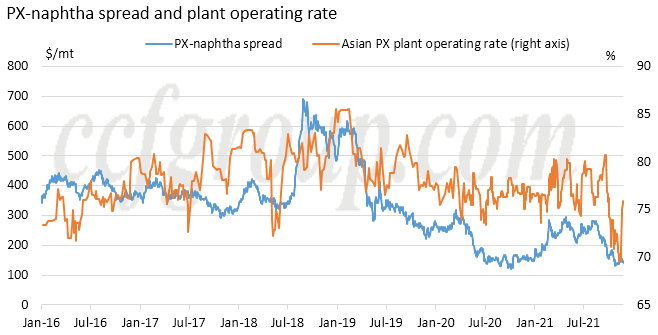PX-naphtha spread and PX plant operating rate
The cost of a product is of great concern for investors, and PX is no exception. However, as PX is one of the products in the refineries and the refineries considers more about the overall material balance and comprehensive benefits which vary from plant to plant, there’s no such unified standard in calculating PX cost.
The profit of a product greatly affect the producers’intention in keeping plant operating rates. The chart below shows Asian PX plant operating rate and the profit (profit hereinafter refers to PX-naphtha spread).

During 2016-2021, polyester industry saw a transit from boom cycle to oversupply cycle. From 2016 to 2019, PX-naphtha spread consolidated at highs and surged in 2018. Asian PX plant operating rate fluctuated upward during the same period, rising from low point of 72% to high point of 85%. Even when the spread was squeezed in some periods during 2016-2017, PX operating rate still ticked up gradually. It reflected that when PX-naphtha spread hovered above $300/mt, producers were highly motivated to keep plant operating rate.
Starting from 2019, however, with the rapid development of refining and chemical integrated projects in China, PX capacity expanded fast. As a result of intensive competition, PX-naphtha spread got squeezed to new lows.
When PX-naphtha spread narrowed to $200-300/mt, the operating rate was around 75-80%. When the spread was in $250-300/mt, any change in operating rate was subtle. When the spread was in $200-250/mt, the operating rate dropped in some periods but the drop was also related to scheduled maintenance or unexpected issues, and hence, the relation between the spread in that range and operating rate was not strikingly high.
When the spread dropped below $200/mt, especially in late Sep 2021, Asian PX plant operating rate slid rapidly from the high point of 80% to as low as 70%. During that period, besides from some plant shutdowns due to dual controls, technical issues as well as scheduled maintenance, some plants cut operating rates because of the poor economics.
In 2020, the spread also once narrowed below $200/mt, but average plant operating rate still stayed above 75%. It was mainly because that after the oil rout in 2020, refineries stocked up crude oil, and thus the production cost was low. In 2021, however, crude oil rose, driving up the cost for refineries. In addition, the profits of benzene declined sharply in the middle of 2021. Therefore, the operating rate in 2021 could more reflect the motivation for plant operation.
In recent years, it can be seen that PX-naphtha spread could find support at around $150/mt. Though it once dropped to $120-130/mt, it did not last long.
In a conclusion, based on the situation of plant operations in recent years, the spread of PX-naphtha at around $150-200/mt could be considered roughly as the acceptable break-even level.
However, as PX continues in capacity expansion cycle, and the competition among PX plants intensifies, PX-naphtha spread may get further squeezed in some periods. However, and squeeze in the spread would be caused by market competition and oversupply rather than any reduction in the cost.
- Top keywords
- Cotton Price
- Cotton Futures Price
- Cotton Futures
- CZCE
- PTA Futures Price
- Chemical Fiber
- Polyester Prices
- Wool price
- PTA Futures
- Shengze Silk
- China
- Yarn Price
- price
- China Textile City
- Fibre Price
- Benzene Price
- Cotton
- Index
- Cotton Index
- PTA
- fabric price
- NYMEX
- Top 10
- textile industry
- Spot Cotton
- Cotton Yarn
- Polyester Price
- Futures
- PTA Price
- cotton yarn price

